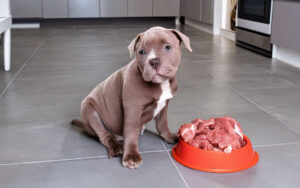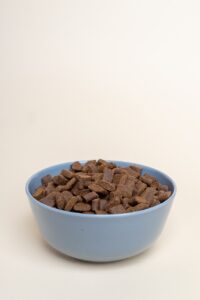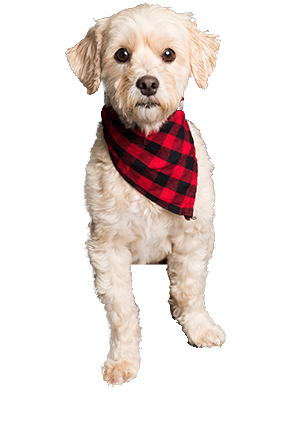
Is Raw Food Right for Your Dog? Find Out Now!
Thinking about switching to raw dog food? 🐶🥩 Discover the pros, cons, and if it’s the right choice for your pup!
As a dog owner, you want what’s best for your furry friend—especially when it comes to their diet. With the growing popularity of raw feeding, many pet parents are wondering: Is a raw food diet the right choice for my dog?
Raw feeding comes with its share of benefits, risks, and misconceptions, so before making the switch, it’s important to understand what it really means and whether it suits your pup’s needs. Let’s break it down!
A raw diet, also known as BARF (Biologically Appropriate Raw Food or Bones and Raw Food), is based on feeding dogs uncooked meats, bones, organs, and fresh produce—similar to what their wild ancestors would eat.
A typical raw diet includes:
✅ Muscle meat (chicken, beef, turkey, etc.)
✅ Raw meaty bones (like chicken wings or necks)
✅ Organ meats (liver, kidney, heart)
✅ Vegetables & fruits (carrots, spinach, apples)
✅ Eggs & dairy (optional, for extra nutrients)
Many dog owners who switch to raw feeding report major improvements in their dog’s health, including:
🐾 Healthier Skin & Shinier Coat – Raw-fed dogs often have softer fur, reduced itchiness, and fewer skin allergies.
🦷 Cleaner Teeth & Fresher Breath – Chewing raw bones naturally cleans teeth, reducing plaque buildup.
💪 Stronger Immune System – Whole, unprocessed foods boost gut health and support better digestion.
🚀 More Energy & Stamina – Dogs on a raw diet often experience better endurance and muscle tone.
💩 Smaller, Less Smelly Poops – Raw food is more digestible, meaning fewer waste materials end up in your yard!
However, while these benefits sound great, raw feeding isn’t for every dog or every owner.

Before switching to raw, it’s important to consider some downsides and risks:
⚠️ Bacterial Contamination – Raw meat can contain salmonella or E. coli, which may be dangerous if not handled properly.
⚠️ Nutritional Imbalance – If not carefully planned, a raw diet can lack key nutrients like calcium, omega-3s, and essential vitamins.
⚠️ Choking & Bone Hazards – Some dogs may choke on bones or suffer from blockages if they aren’t used to chewing properly.
⚠️ Cost & Time Commitment – Raw feeding can be more expensive than kibble and requires meal planning, storage, and preparation.
A raw diet may be a great option for some dogs, but not for all. Consider these factors before deciding:
✔️ Breed & Size: Some breeds thrive on raw, while others (like brachycephalic breeds) may struggle with chewing raw bones.
✔️ Age & Health Condition: Puppies, senior dogs, and dogs with certain medical conditions (e.g., kidney disease) may require special dietary adjustments.
✔️ Your Lifestyle: If you have a busy schedule, raw feeding might not be practical. Kibble or commercially prepared raw meals could be a better option.
✔️ Your Budget: Raw feeding can cost more than kibble, especially if you choose high-quality, organic meats.
✔️ Your Comfort Level: Are you comfortable handling raw meat and maintaining strict food safety precautions?
If you decide that raw food is the right choice for your pup, transitioning gradually is key:
🐶 Start Slow – Introduce small amounts of raw food alongside your dog’s regular meals.
🥩 Choose the Right Proteins – Start with easily digestible meats like chicken or turkey before introducing richer proteins like beef or lamb.
🔄 Monitor Your Dog’s Reaction – Look out for digestive issues, changes in stool, or allergic reactions.
💧 Provide Fresh Water – Hydration is essential, especially when switching to a high-protein diet.
📋 Consult a Vet or Canine Nutritionist – To ensure a balanced diet, seek professional advice for the right nutrient ratios.
A raw diet can offer amazing health benefits, but it’s not the right choice for every dog or owner. Before switching, do your research, plan carefully, and consult your vet.
If raw feeding works for your lifestyle and your pup thrives on it—great! If not, don’t worry—there are plenty of other healthy feeding options available.
Would you like more raw feeding tips, meal plans, or DIY recipes? Drop a comment below and let me know! 🐶🥩✨
Watch the video by clicking the thumbnail below.
🔔 Don’t forget to share this post with fellow dog parents who are curious about raw feeding! 🚀🐾

Thinking about switching to raw dog food? 🐶🥩 Discover the pros, cons, and if it’s the right choice for your pup!

Discover the top mistakes people make when using dog training treats and how to correct them for better results with your puppy!

Tired of leash pulling ruining your walks? Learn the secrets to stress-free, enjoyable walks with your puppy in our latest blog!
